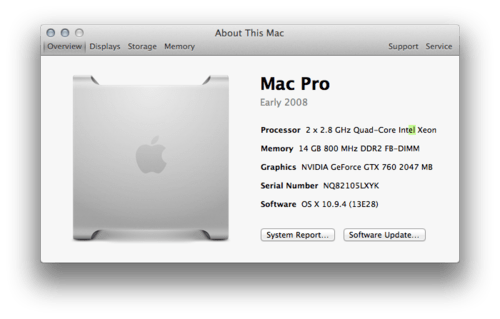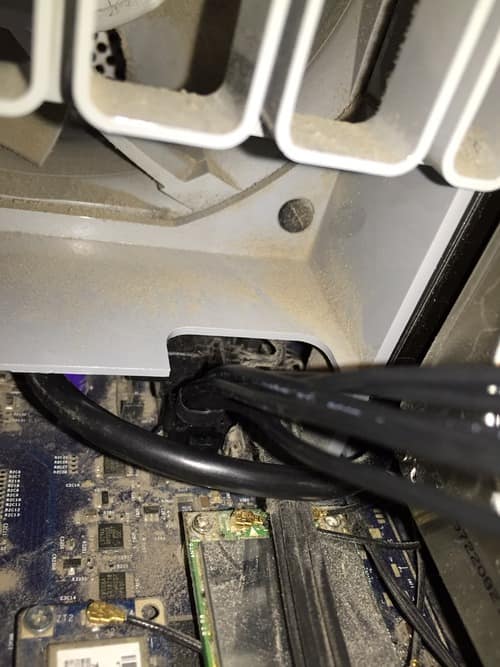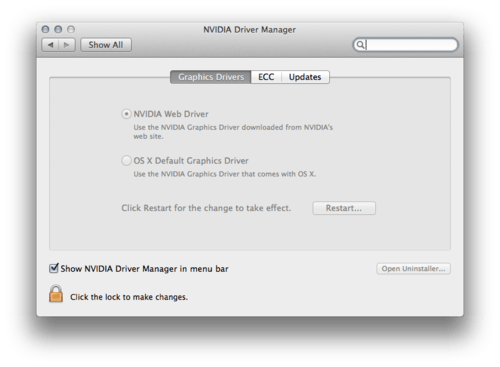Installing a GeForce GTX760 (GeForce GTX770/GTX780) into a 2006-2008 Mac Pro
Update March 29th, 2018
A quick heads up, I've added a new article on the GeForce GTX 1060 / 1070 / 1080 series, the information is still true but a bit dated. I recommend using preinstalling the nVidia web drivers, TonyMacX86 keeps a nice list running of version to OS version. 10.13 High Sierra or 10.12 Sierra
Below is the original instructions for installing the GeForce 700 series in a Mac Pro.

One of the unsung beauties of the later nVidia cards is they have Mac bios built in. Gone are the days of having to buy a “Mac” version of a graphics card that came preloaded with the proper BIOS or taking matters into your own hands by locating a Mac rom and flashing your graphics cards, and installing the drivers. (the first graphics card I flashed, a Geforce 3, required a PC to run the NVflash.exe). Even as 2011, I flashed an the AMD Radeon 6870 with Mac EFI Firmware. Now you can buy cards off the shelf and jam them in your Mac Pro.
I’ve noted the process in my “Recommended Mac Pro Upgrades” but I realize some users may want a more in-depth guide. Dropping a $200 graphics card into a 6 year old computer might seem crazy but with a GTX760, Borderlands 3 and Shadows of Mordor both run at 2560 x 1440, (max settings for Borderlands: The Prequel Sequel, nearly maxed out, sans the 4GB textures for Shadows of Mordor since opted for the 2GB GTX760). I’ve attached at the bottom benchmarks, further evidencing that the Mac Pro 2008 is still a viable computer for gaming. You can even find videos of youtubers jamming 970s into Mac Pros, so sky’s the limit.
This guide is also a blueprint for the ones looking sticking the GTX960 and GTX970 into Mac Pros.
Here’s how to get your Mac Pro loaded up with snazzy new graphics card in three easy steps!
Be aware::
- The nVidia drivers currently require 10.9 Mavericks or above, although you may be able to track down older drivers.
- The nVidia cards will load the EFI boot screen with the card plugged in (the screen you see if you hold down the option key and the Apple logo). You’ll want to have a backup graphics card in another slot with a monitor connected to see video before the OS X user screen. I personally have an ATI Radeon HD 2600 XT that shipped with my computer but any graphics card will do, flashed or factory as long as it can display the Apple logo on boot. You can operate the computer without an EFI graphics card, however you’ll have to manage booting using Start Up Disk in OS X and use the bootcamp tools in Windows to manage your boot drives. At the very least, keep your old graphics card somewhere safe should you ever need to do troubleshooting.
Step 1)
Purchase a graphics card, and extra mini-PCIe to standard PCIe power cable(s).
The Mac Pros use a funky mini-six-pin cable so you can’t just buy any PCIe power cable. The Mac Pro ship with two power ports. I personally bought a PCIe PCI-e Dual 6 pin Power Cable for Mac G5 nVidia ATI Video Card (Disregard the G5 mislabeling on Amazon, its for a Mac Pro ).
Modern graphics cards power hogs, especially compared to later generation Core series CPUs which continually dropped power requirements between generations. The amount of power connectors, reflect power requirements.
Chart of power supply delivery based on PCIe power pinouts
75 Watts
None
150 Watts
One six-pin connector
225 Watts
Two six-pin connectors (or one 8-pin)
300 Watts
One eight-pin connector + one six-pin connector
375 Watts
Two eight-pin connectors
450 Watts
Two eight-pin connectors + one six-pin connector
Since the Mac Pros 2006-2008 do not have eight-pin outs, you’ll need a six to eight pin adapter which requires two sets of six-pin cables (hence where the Y pin comes into play). For most GTX 760s and 770s you’ll need three 6 Pin power cables, meaning at least one Y cable like the one linked above.
Next any off the shelf GeForce GTX760 or GTX770 or GTX780 will do. Personally I picked up a EVGA GeForce GTX760 SuperClocked as I’m only a moderate gamer, You certainly will see benefits by dropping more money on a higher end graphics card. I’d recommend more serious gamers getting one of the 4 GB cards as the newest games make use of the addition VRAM for high resolution textures. The 4 GB GTX770s run about $350 as of writing this, spendy but incredibly powerful for the dollar.
Some GeForce GTXes may require one or two 8 pin plugins. The graphics card I purchased required one eight-pin cable and came with a six to eight- pin adapter. This means I needed a grand total of three six-pin cables.
The Mac Pro 2008 shipped with the incredibly beefy 980w PSU. Even under full load according to Apple, the Mac Pro’s CPUs only draw 318w of power. Even with 4 bays filled 3.5 inch HDs, (under full loads 7200 drives only consume roughly 10w) and full ram load out (10w a stick under max load) would leave 450w (if it were feasible trigger full load on CPUs/RAM/HDDs) for motherboard/fans/PCIe cards. Needless to say, the Mac Pro has plenty of headroom (short of trying to run SLI).
Summary
The TL;DR: You’ll likely need additional power cables specifically designed for the mini-PCIe 6 pin power cables. You can get them here: PCIe PCI-e Dual 6 pin Power Cable for Mac G5 nVidia ATI Video Card (Disregard the G5 mislabeling). Unless you’re attempting an SLI configuration, your Mac Pro has plenty of wattage to spare.
Please read, September 1 2015 update: I’ve received a few e-mails about cabling. You will need to utilize both PCIe port ports on your Mac pro. This means you’ll likely need to purchase the PCIe PCI-e Dual 6 pin Power Cable. One of the Mac Pro’s 6 pin adapters should connect to the 6 pin power input on the graphics card, and the other port should connect to a 6 pin to 8 pin adapter. Many graphics cards come with 6 to 8 pin Y adapters. A reader reports that trying to connect a graphics 6 pin and 8 all to one PCIe power port does not work. Use both ports.
Step 2)
Plugging in your PCIe power cables.

The PCIe power cables are located near the front of the PCI chamber beneath the forward fans, right next to the Airport card (or airport card slot). Its a squeeze but I was able to do it with my bare hands.
Step 3)
You’ll want to have a secondary graphics card otherwise this can be a pain. Install the new graphics card and move your old graphics card to another slot. Leave a monitor connected to your old graphics card (if you have two displays, connect one to each graphics card) and boot up your Mac Pro. Download install the drivers from here. The drivers will require you to reboot. On reboot, plug in your monitor to your new graphics card. If you have a secondary display, leave one monitor plugged into your old display if you’d like to continue to be able to see your EFI boot screens.
If your new video card still isn’t outputting video, go the preferences and to the nVidia Driver Manager and make sure you’re using nVIdia’s Web drivers.

Installing on windows will require the usual process of downloading and installing the drivers from nVidia’s website.
Benchmarks and Comparisons
You’re probably wondering if its even worth sticking a GTX760 in a six year old computer vs a Hackintosh Core i7 3770k on a Quo Motherboard? The results may be surprising. All the benchmarks have been performed with the exact same install of OS X.
OS X 10.9 (Mavericks) benchmarks:
Settings:
OpenGL 1600x900 8xAA windowed, Quality: Ultra, Tessellation: Extreme
Mac Pro 2008 (Xeon E5462 2.8 Ghz) + GeForce GTX 760 + 14 GB RAM + Samsung 840 750 GB SSD
FPS: 32.7
Score: 825
Min FPS: 15.7
Max FPS: 68.9
Hackintosh (i7 3770k 3.5 GHz) + GeForce GTX 760 + 16 GB RAM + Samsung 840 750 GB SSD
FPS: 35.7
Score: 899
Min FPS: 7.4
Max FPS: 91.2
Hackintosh (i7 3770k 3.5 GHz) + GeForce GTX 770 + 16 GB RAM + Samsung 840 750 GB SSD
FPS: 43.0
Score: 1082
Min FPS: 10.3
Max FPS: 103.6
——————————————————————————
OpenGL 2560 x 1440 8xAA FullScreen Quality:Ultra Tessellation: Extreme
Mac Pro 2008 (Xeon E5462 2.8 Ghz) + GeForce GTX 760 + 14 GB RAM + Samsung 840 750 GB SSD
FPS: 16.1
Score: 405
Min FPS: 5.8
Max FPS: 37.4
Hackintosh (i7 3770k 3.5 GHz) + GeForce GTX 760 + 16 GB RAM + Samsung 840 750 GB SSD
FPS: 15.7
Score: 396
Min FPS: 6.9
Max FPS: 37.3
Hackintosh (i7 3770k 3.5 GHz) + GeForce GTX 770 + 16 GB RAM + Samsung 840 750 GB SSD
FPS: 18.8
Score: 474
Min FPS: 7.6
Max FPS: 47.5
The Core i7 has an advantage, especially for brief maximums but it shouldn’t come as a huge surprise that the Mac Pro holds its own. However, at the max resolution, the Mac Pro bests faster Core i7. Notably the GeForce 770GTX makes a difference but not quite as much as one might suspect under OS X. Surprising indeed. What’s clear is the GPU is the bigger bottleneck than the CPUs.
I’m left to purely speculate that this may be in part due to the fact the Mac Pro has 12MB of l2 cache per CPU vs 8 MB of L2 cache shared, and 32k L1 cache per CPU vs a single 32K of L1, and the Mac Pro has a 6.4 GT/s bus vs the 5 GT/s found in the Z77 Express Chipset. It also could be as simple a driver update. The big takeaway is that a 6 year old computer was able to compete with a CPU that’s a year old.
The Core i7’s beefier bus speed, newer instruction sets, higher clock speed and Turbo Boost technology 2.0 (CPU auto overclock) all aid in higher max frame rates, when the GPU isn’t under full load. The Unigine benchmark is a nice stress test of OpenGL but may not illustrate nearly as full a benchmark as windows only Benchmarks like 3Dmark. Also notably Unigine produces better OpenGL benchmarks in Windows, and even more so with DirectX.
I’d love to see 2014 5k iMac with the Radeon R9 M295X to throw into the mix. It’s likely my Mac Pro 2008 would be only a few FPS shy of the iMac, based on GPU Boss.
The short of it, if you want a gaming Mac, an older Mac Pro with a modern GPU is your best bet to this day. The new iMac 5k display is something to marvel, but the GPU (even if absurdly powerful for a mobile chipset) is not when pushing so many pixels. For about $600 you can score a 2008 Mac Pro, making it a bit of a steal
The Core i7 3770k was released on April 29, 2012 vs the E5462 in Nov 12, 2007.
Update January 19th, 2015
What About the GeForce GTX 9xxs / 10xx you may ask?
If you’re like myself, you may be wondering if you can jam a GeForce GTX 980, 970, 960 or GTX 1080, 1070, 1060 etc in your Mac Pro? The answer is: Yes, yes you can. You gotta love the Hackintosh community and nVidia. You can even watch youtubers jam the 970s into Mac Pros.
Update September 1st, 2015
Added more information about the Y adapter and GeForce GTX 9xx series. Also, the GeForce 760 was more than enough to play GTA V at nearly maxed at 2560 x 1440 and medium textures. To use the high resolution textures, you need a 4 GB card and the same goes for Shadows of Mordor In hindsight I probably should have stuck with the 770 4GB edition.
The Witcher 3 runs fantastically too. My 2013 Retina MacBook Pro with the dedicated GeForce GT 650m simply cannot play these games. The 2008 Mac pro can. Enough said.
Update January 3rd, 2016
Noticed that the driver information listed Mavericks or Yosemite, changed it to “Mavericks or Above”. Added a little more clarification after a reader asked about EFI boot screens. Also, I’ll probably end up making a sequel article when it comes time to get a GeForce GTX 970.
Update March 29th, 2018
Minor typo fixes and new intro, added info about the 1000 series.